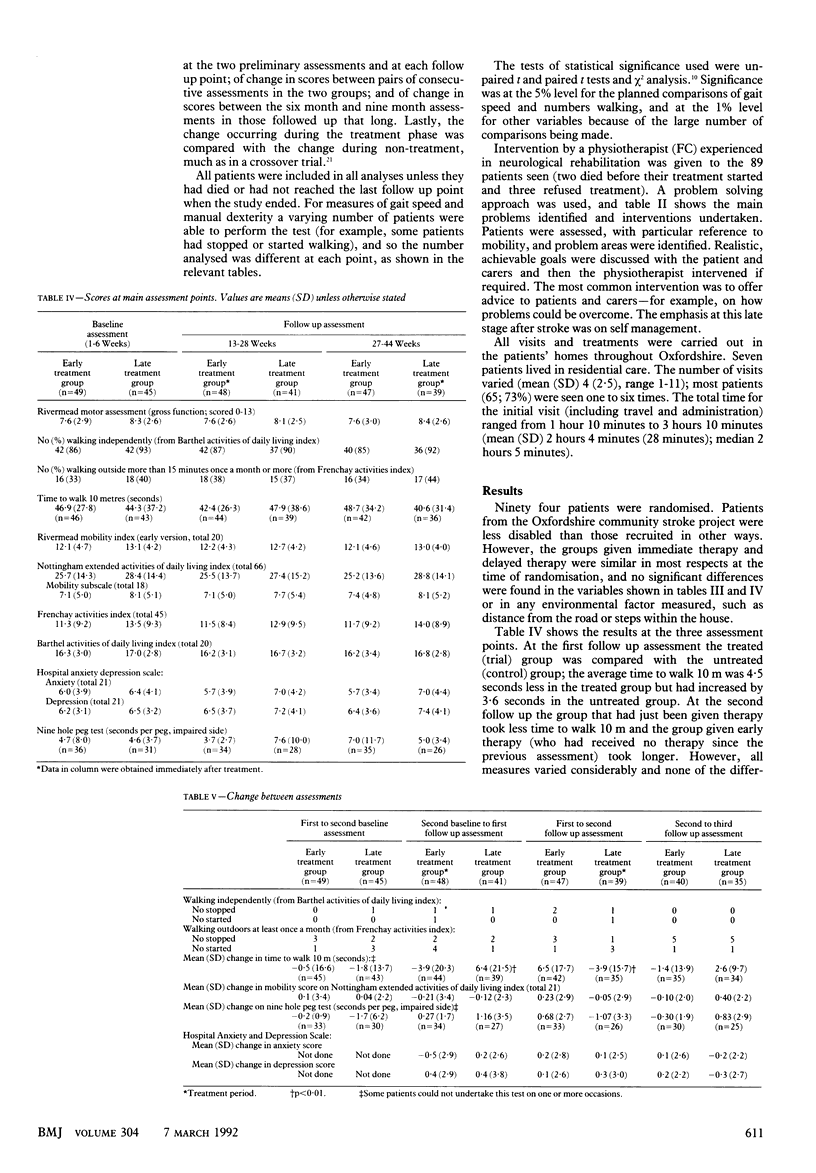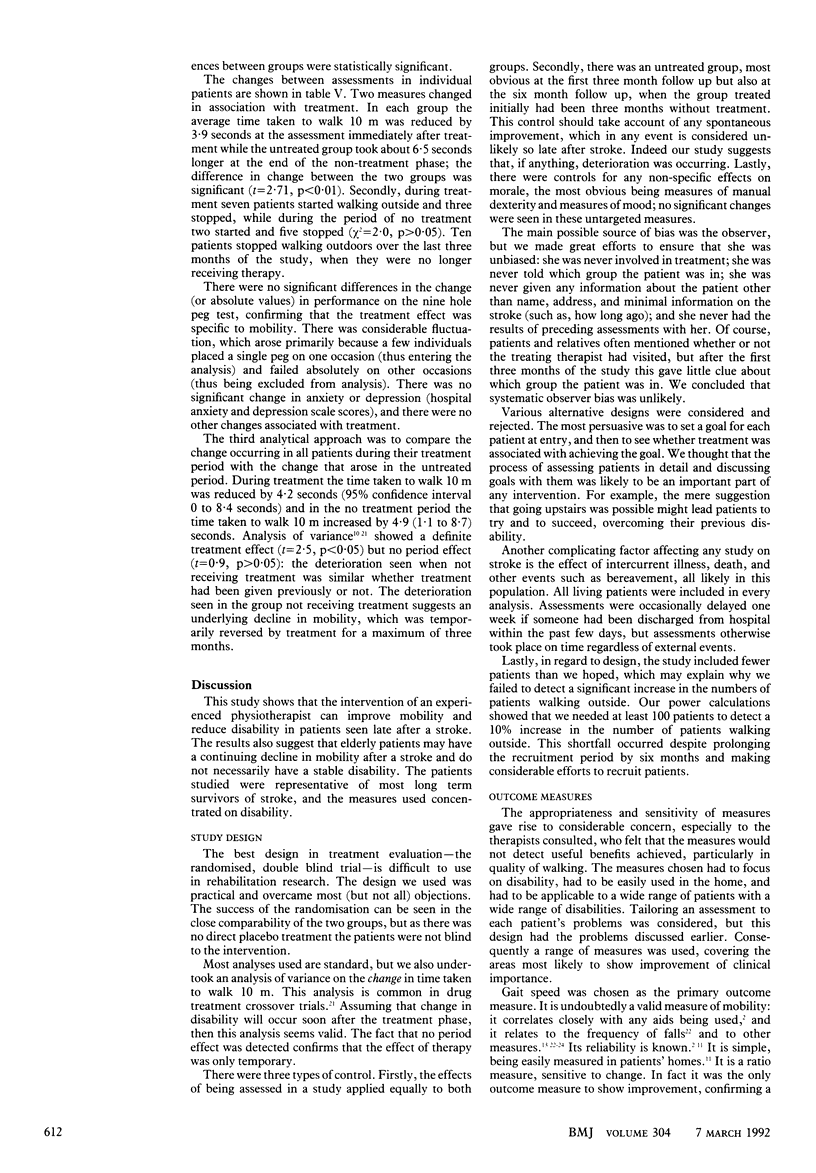Abstract
OBJECTIVE--To determine whether the intervention of a physiotherapist improved mobility in patients seen more than one year after stroke. DESIGN--Randomised crossover trial comparing two groups offered intervention by a physiotherapist, one immediately after entry into the trial and the other after a delay of three months. The intervention consisted of identifying problems and offering advice and help to solve the problems. SETTING--Patients' homes in Oxfordshire. SUBJECTS--Patients who had reduced mobility due to a stroke more than one year before entry; 60 were recruited from a community stroke register and 34 in other ways. MAIN OUTCOME MEASURES--Standard measures of mobility including gait speed, functional ambulation categories, the Nottingham extended activities of daily living index, and individual items from the Barthel activities of daily living index and the Frenchay activities index. Measures of manual dexterity, depression, and anxiety were used as controls. RESULTS--94 patients entered the trial and 49 were randomised to immediate and 45 to delayed physiotherapy; 89 were compared at the crossover point. At randomisation the two groups were comparable. At three months the group given early therapy showed an improvement in gait speed whereas the untreated group had declined (differences of -3.9 v 6.4 s to walk 10 m; p less than 0.01); between three and six months the group given delayed therapy showed improvement and the previously treated group declined (differences of 6.5 v -3.9 s to walk 10 m; p less than 0.01). A 9% (95% confidence interval 0% to 18%) decrease in time taken to walk 10 m was associated with treatment and a 12% (2% to 19%) increase when patients were untreated. Other measures did not change significantly. CONCLUSION--Intervention of an experienced physiotherapist late after stroke specifically improves mobility, albeit by a small amount, but the effects do not seem to be maintained, perhaps because there is an underlying decline in mobility in these patients. Gait speed offers a simple and sensitive measure of outcome.
Full text
PDF




Selected References
These references are in PubMed. This may not be the complete list of references from this article.
- Bamford J., Sandercock P., Dennis M., Warlow C., Jones L., McPherson K., Vessey M., Fowler G., Molyneux A., Hughes T. A prospective study of acute cerebrovascular disease in the community: the Oxfordshire Community Stroke Project 1981-86. 1. Methodology, demography and incident cases of first-ever stroke. J Neurol Neurosurg Psychiatry. 1988 Nov;51(11):1373–1380. doi: 10.1136/jnnp.51.11.1373. [DOI] [PMC free article] [PubMed] [Google Scholar]
- Brandstater M. E., de Bruin H., Gowland C., Clark B. M. Hemiplegic gait: analysis of temporal variables. Arch Phys Med Rehabil. 1983 Dec;64(12):583–587. [PubMed] [Google Scholar]
- Burnside I. G., Tobias H. S., Bursill D. Electromyographic feedback in the remobilization of stroke patients: a controlled trial. Arch Phys Med Rehabil. 1982 May;63(5):217–222. [PubMed] [Google Scholar]
- Collen F. M., Wade D. T., Bradshaw C. M. Mobility after stroke: reliability of measures of impairment and disability. Int Disabil Stud. 1990 Jan-Mar;12(1):6–9. doi: 10.3109/03790799009166594. [DOI] [PubMed] [Google Scholar]
- Collen F. M., Wade D. T. Residual mobility problems after stroke. Int Disabil Stud. 1991 Jan-Mar;13(1):12–15. doi: 10.3109/03790799109166270. [DOI] [PubMed] [Google Scholar]
- Collen F. M., Wade D. T., Robb G. F., Bradshaw C. M. The Rivermead Mobility Index: a further development of the Rivermead Motor Assessment. Int Disabil Stud. 1991 Apr-Jun;13(2):50–54. doi: 10.3109/03790799109166684. [DOI] [PubMed] [Google Scholar]
- Collin C., Wade D. T., Davies S., Horne V. The Barthel ADL Index: a reliability study. Int Disabil Stud. 1988;10(2):61–63. doi: 10.3109/09638288809164103. [DOI] [PubMed] [Google Scholar]
- Corcoran P. J., Jebsen R. H., Brengelmann G. L., Simons B. C. Effects of plastic and metal leg braces on speed and energy cost of hemiparetic ambulation. Arch Phys Med Rehabil. 1970 Feb;51(2):69–77. [PubMed] [Google Scholar]
- Heller A., Wade D. T., Wood V. A., Sunderland A., Hewer R. L., Ward E. Arm function after stroke: measurement and recovery over the first three months. J Neurol Neurosurg Psychiatry. 1987 Jun;50(6):714–719. doi: 10.1136/jnnp.50.6.714. [DOI] [PMC free article] [PubMed] [Google Scholar]
- Holden M. K., Gill K. M., Magliozzi M. R., Nathan J., Piehl-Baker L. Clinical gait assessment in the neurologically impaired. Reliability and meaningfulness. Phys Ther. 1984 Jan;64(1):35–40. doi: 10.1093/ptj/64.1.35. [DOI] [PubMed] [Google Scholar]
- Lehmann J. F., DeLateur B. J., Fowler R. S., Jr, Warren C. G., Arnhold R., Schertzer G., Hurka R., Whitmore J. J., Masock A. J., Chambers K. H. Stroke: Does rehabilitation affect outcome? Arch Phys Med Rehabil. 1975 Sep;56(9):375–382. [PubMed] [Google Scholar]
- Lincoln N., Leadbitter D. Assessment of motor function in stroke patients. Physiotherapy. 1979 Feb;65(2):48–51. [PubMed] [Google Scholar]
- May D., Nayak U. S., Isaacs B. The life-space diary: a measure of mobility in old people at home. Int Rehabil Med. 1985;7(4):182–186. doi: 10.3109/03790798509165993. [DOI] [PubMed] [Google Scholar]
- Wade D. T., Hewer R. L. Functional abilities after stroke: measurement, natural history and prognosis. J Neurol Neurosurg Psychiatry. 1987 Feb;50(2):177–182. doi: 10.1136/jnnp.50.2.177. [DOI] [PMC free article] [PubMed] [Google Scholar]
- Wade D. T., Legh-Smith J., Langton Hewer R. Social activities after stroke: measurement and natural history using the Frenchay Activities Index. Int Rehabil Med. 1985;7(4):176–181. doi: 10.3109/03790798509165991. [DOI] [PubMed] [Google Scholar]
- Wade D. T., Wood V. A., Heller A., Maggs J., Langton Hewer R. Walking after stroke. Measurement and recovery over the first 3 months. Scand J Rehabil Med. 1987;19(1):25–30. [PubMed] [Google Scholar]
- Zigmond A. S., Snaith R. P. The hospital anxiety and depression scale. Acta Psychiatr Scand. 1983 Jun;67(6):361–370. doi: 10.1111/j.1600-0447.1983.tb09716.x. [DOI] [PubMed] [Google Scholar]


